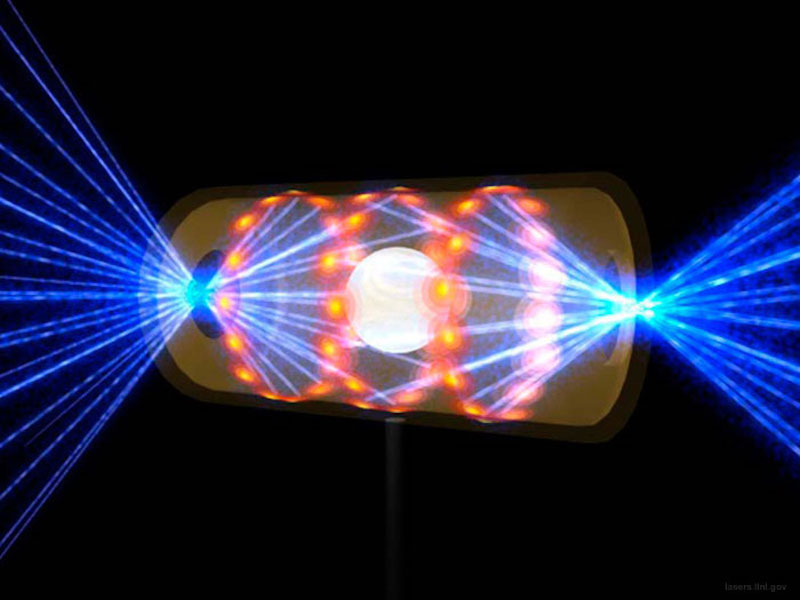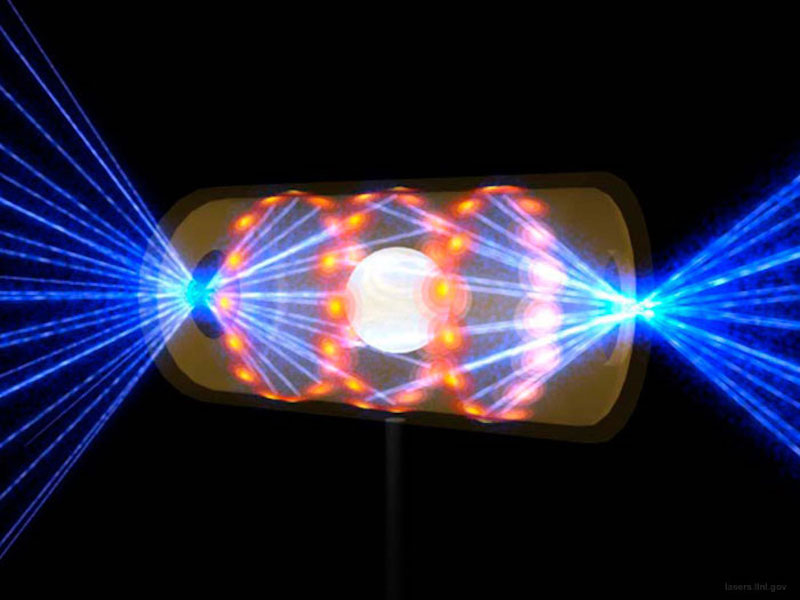Fusion Turns Up the Heat
The National Ignition Facility (NIF) uses the world’s largest laser to heat and compress a small capsule containing hydrogen fuel and thereby induce nuclear fusion reactions in the fuel (Fig. 1), an approach known as inertial confinement fusion [1]. In early 2021, a team at NIF achieved a major milestone by showing that they could produce a burning plasma [2], a state in which the dominant source of fuel heating is self-heating due to fusion reactions—rather than external heating by the laser pulses. Today, NIF reports that they have reached another milestone in fusion research: they produced a plasma in which self-heating locally surpasses not only the external heating but also all loss mechanisms, fulfilling the so-called Lawson criterion for fusion ignition [3–5]. The result brings the scheme tantalizingly close to a holy grail of the field—getting fusion to produce a net energy greater than that contained in the driving laser pulses.
In the burning-plasma state attained in 2021, the laser still had to deliver a lot of energy to keep the fusion reaction going. However, for a “fire” to start spreading through the fuel, it should sustain itself without further energy input. To achieve that condition, the reaction must produce more energy locally than it loses to the environment. The excess energy can then heat other parts of the fuel up to the point that they also start undergoing fusion. In physical terms, the heating of the fuel generated by fusion must exceed the losses due to heat conduction and radiation. This is exactly what happens when we ignite and burn traditional fuels like paper, wood, or coal: the heat from the burning part increases the temperature locally and sets fire to the adjacent, previously cold, fuel.
The condition required to reach this point for a fusion reactor was first formulated in 1955 by engineer and physicist John Lawson [6, 7]. A fusion reaction can only take place in a plasma (a hot, ionized gas) at temperatures exceeding 100 million degrees (or, expressed in electron volts, 104eV). The challenge is keeping such a hot gas confined for a sufficiently long enough time for the rate of energy production by fusion to exceed the rate of energy loss to the environment. For a continuously burning plasma, Lawson’s criterion states that ignition occurs when the product of the plasma density, n, and the confinement time, 𝜏, is larger than a certain threshold. For the case of a deuterium-tritium fuel such as that used by NIF, n⋅𝜏 must exceed 1021s⋅m−3 at more than 100 million degrees. The criterion is more often formulated in terms of a triple product of n⋅T⋅𝜏, where T is the temperature. For the same type of plasma, n⋅T⋅𝜏 must exceed 1025eV⋅s⋅m−3. This threshold has now been achieved by NIF.
The new results (see Research News: Ignition First in a Fusion Reaction) build on the advances in fuel, instruments, and methods that allowed the team to achieve the burning-plasma condition [4, 5]. To go beyond that point, the researchers implemented a series of small, but carefully planned, changes that had a big effect on performance. For instance, the team reduced the size of the laser entrance holes of the “oven” cavity surrounding the fusion capsule, requiring less energy to heat the capsule in the initial phase of the implosion. The energy “saved” by this step allowed the laser pulses to be shaped so that more energy was allocated to the pulse tail. This energy redistribution increased the late-time ablation pressure on the capsule, giving an extra kick to the implosion at about the right time. They also improved the quality of the oven and of the capsule, for instance, by minimizing any deviations from a perfectly spherical capsule geometry. Such deviations lead to spatial perturbations that grow during the implosion, mixing hot and cold fuel regions and making ignition more difficult to achieve [1]. Finally, the team improved the stability and spatial profile of the 192 laser beams hitting the target—changes that helped maintain the spherical symmetry of the imploding sphere.
The results are a testament to the tremendous progress of fusion research, which is often accused of moving too slowly to be useful in view of the looming climate crisis. To understand the magnitude of fusion’s progress, it’s useful to compare it with that of computers—a technology that we’d all agree has moved extremely fast. The pace of computer development is well captured by Moore’s law, which states that the number of transistors on a chip doubles about every two years. Today, there are nearly a million times more transistors on a chip than there were 50 years ago. On a similar timeline, the key figure of merit of fusion—the triple product—has grown just as fast as transistor density.
So, what’s still missing for fusion-based power plants to become a reality? Fulfilling the Lawson criterion for a burning plasma doesn’t yet mean that we can produce useful energy with fusion power plants. The next step toward that goal would be to demonstrate a fusion scheme that produces as much energy as that contained in the laser pulses driving the reaction. In other words, the scheme should have a net gain, G, of 1. In NIF’s experiments, G=0.72. The current results are thus tantalizingly close to achieving unit gain—at the current rate of improvement, I expect this to happen within the next couple of years. But for a fusion reactor to be commercially viable and deliver a sizeable amount of electricity to the grid, much higher gains (of order 100) are needed to compensate for the wall-plug efficiency of the laser and for the losses in energy collection and in the electricity production and distribution system. There are also other challenges to overcome, such as generating the tritium fuel as part of an integrated cycle within the power plant.
Without doubt, fusion reactors are going from strength to strength, both in the laser-driven approach, as shown by the NIF results, and in the competing approach of magnetic confinement [8], which has many features that make it better matched to the engineering of power plants. These advances suggest that fusion energy may yet play an important part in humanity’s future.
References
- J. Lindl, “Development of the indirect-drive approach to inertial confinement fusion and the target physics basis for ignition and gain,” Phys. Plasmas 2, 3933 (1995).
- A. B. Zylstra et al., “Burning plasma achieved in inertial fusion,” Nature 601, 542 (2022).
- H. Abu-Shawareb et al. (Indirect Drive ICF Collaboration), “Lawson criterion for ignition exceeded in an inertial fusion experiment,” Phys. Rev. Lett. 129, 075001 (2022).
- A. L. Kritcher, “Design of an inertial fusion experiment exceeding the Lawson criterion for ignition,” Phys. Rev. E 106, 025201 (2022).
- A. B. Zylstra et al., “Experimental achievement and signatures of ignition at the National Ignition Facility,” Phys. Rev. E 106, 025202 (2022).
- J. D. Lawson, Atomic Energy Research Establishment, Report No. GP/R 1807 (1955).
- J. D. Lawson, “Some criteria for a power producing thermonuclear reactor,” Proc. Phys. Soc. B. 70, 6 (1957).
- European Commission, “Fusion energy breakthrough at the world-leading Joint European Torus facility,” News (2022).





